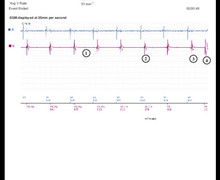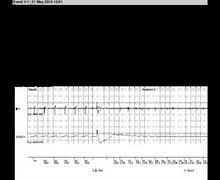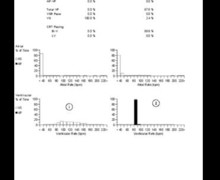Successful burst of ATP for VT
Tracing
Manufacturer Boston Scientific
Device ICD
Field Therapy
N° 6
Patient
This 61-year-old man presenting with severe ischemic cardiomyopathy and complete AV block underwent implantation of a Bston Science Incepta triple chamber defibrillator. He was seen on a routine follow-up visit when multiples episodes of VT each treated with a single sequence of ATP were retrieved from the device memory.
Summary
Diagnosis of VT made by the device, requiring a sequence of ATP. No discrimination was programmed for this pacemaker-dependent patient.

Graph and trace
Tracing
- spontaneous rhythm in atrium with biventricular stimulation;
- regular monomorphic VT (AV dissociation), diagnosed in the VT zone;
- episode of VT (V-Epsd) after 8 out of 10 cycles in the VT zone; onset of initial Duration of the VT zone (2.5 sec);
- diagnosis of sustained VT (V-Detect) at the end of the Duration;
- burst of 8 cycles at a fixed rate; biventricular stimulation;
- successful burst and termination of the arrhythmia.
Other articles that may be of interest to you







This clinical case illustrates the ability of ATP to treat VT at rates <200 bpm. Despite the occurrence of multiple episodes of VT in recent months, an expeditious and effective pacing therapy kept the patient symptom-free and preserved his quality of life. This painless therapy also spares the batteries. In the <200 bpm VT zone, ATP can be programmed in the majority of patients suffering from heart failure who undergo device implants for secondary prevention, as well as primary prevention, unless it has been found ineffective or proarrhythmic. In this range of rates, ATP can terminate >90% of VT episodes, and accelerates the tachycardia or induces VF in ≤1% of cases.